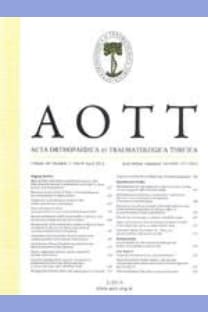Sıçan siyatik sinir modelinde fonksiyonel değerlendirme yöntemlerinin yeni bir sistemle karşılaştırılması
Lokomosyon, Siyatik sinir, Sinir yenilenmesi, Sıçanlar, Hastalık modelleri, hayvan, Ekstremiteler, Ayak, Ayak parmakları
Comparison of the functional evaluation methods in rat sciatic nerve model by a new system
Locomotion, Sciatic Nerve, Nerve Regeneration, Rats, Disease Models, Animal, Extremities, Foot, Toes,
___
- 1. de Medinaceli L, Freed WJ, Wyatt RJ. An index of the functional condition of rat sciatic nerve based on measurements made from walking tracks. Exp Neurol 1982;77:634-43.
- 2. Shen N, Zhu J. Application of sciatic functional index in nerve functional assessment. Microsurgery 1995;16:552-5.
- 3. Brown CJ, Mackinnon SE, Evans PJ, Bain JR, Makino AP, Hunter DA, et al. Self-evaluation of walking-track measurement using a Sciatic Function Index. Microsurgery 1989;10:226-35.
- 4. Lin FM, Pan YC, Hom C, Sabbahi M, Shenaq S. Ankle stance angle: a functional index for the evaluation of sciatic nerve recovery after complete transection. J Reconstr Microsurg 1996;12:173-7.
- 5. Walker JL, Evans JM, Meade P, Resig P, Sisken BF. Gait-stance duration as a measure of injury and recovery in the rat sciatic nerve model. J Neurosci Methods 1994;52:47-52
- 6. Brown CJ, Evans PJ, Mackinnon SE, Bain JR, Makino AP, Hunter DA, et al. Inter- and intraobserver reliability of walking-track analysis used to assess sciatic nerve function in rats. Microsurgery 1991;12:76-9.
- 7. Hare GM, Evans PJ, Mackinnon SE, Best TJ, Brain JR, Szalai JP, Hunter DA. Walking track analysis: a long-term asssessment of peripheral nerve recovery. Plast Reconstr Surg 1992;89:251-8.
- ISSN: 1017-995X
- Yayın Aralığı: 6
- Başlangıç: 2015
- Yayıncı: Türk Ortopedi ve Travmatoloji Derneği
Mehmet AŞIK, Nadir ŞENER, Fatih DİKİCİ, Cengiz ŞEN
Semptomatik fenestre medial plika: İki olgu
Sercan AKPINAR, Necip CESUR, Murat A. HERSEKLİ, Hüseyin DEMİRÖRS, Reha N. TANDOĞAN
Proksimal humerus kırıklarında hemiartroplasti sonuçlarını etkileyen faktörler
Diskoid lateral menüsküs ve artroskopik tedavisi
Mehmet AŞIK, Cengiz ŞEN, Fatih DİKİCİ, Yunus V. SÖZEN, Ömer TAŞER, Aziz K. ALTURFAN
Subakromial sıkışma sendromunun evrelendirilmesinde kullanılan tanısal yöntemlerin karşılaştırılması
Hüseyin SARISALTIK, Orhan AKINCI, Hakan GÜRBÜZ
Yetkin SÖYÜNCÜ, Mustafa ÜRGÜDEN, F. Feyyaz AKYILDIZ, HAKAN ÖZDEMİR, Erdoğan ALTINEL
Şenol AKMAN, SEMİH AYANOĞLU, Bülent AKSOY, Fevziye KAVUKÇUOĞLU, İrfan ÖZTÜRK
Posttravmatik alt ekstremite deformitelerinin Ilizarov yöntemi ile tedavisi
Ercan KÖSEOĞLU, Cemil YILDIZ, A. Sabri ATEŞALP, Mustafa BAŞBOZKURT, Ethem GÜR
Mehmet DEMİRKAYA, Hasan KARA, Yakup YILDIRIM, Zafer ORHAN, Mustafa ŞİRVANCI
Levent ERALP, Mehmet KOCAOĞLU, Ata Can ATALAR, Şamil AKTAŞ, Salih AYDIN, Okan SOYHAN, Maktav DİNÇER, Vakur OLGAÇ, Rian DİŞÇİ
